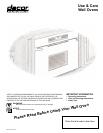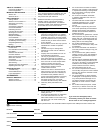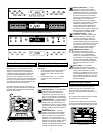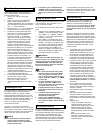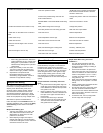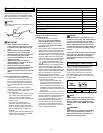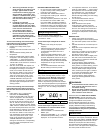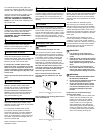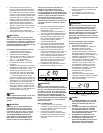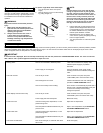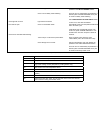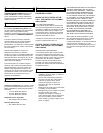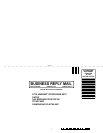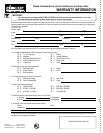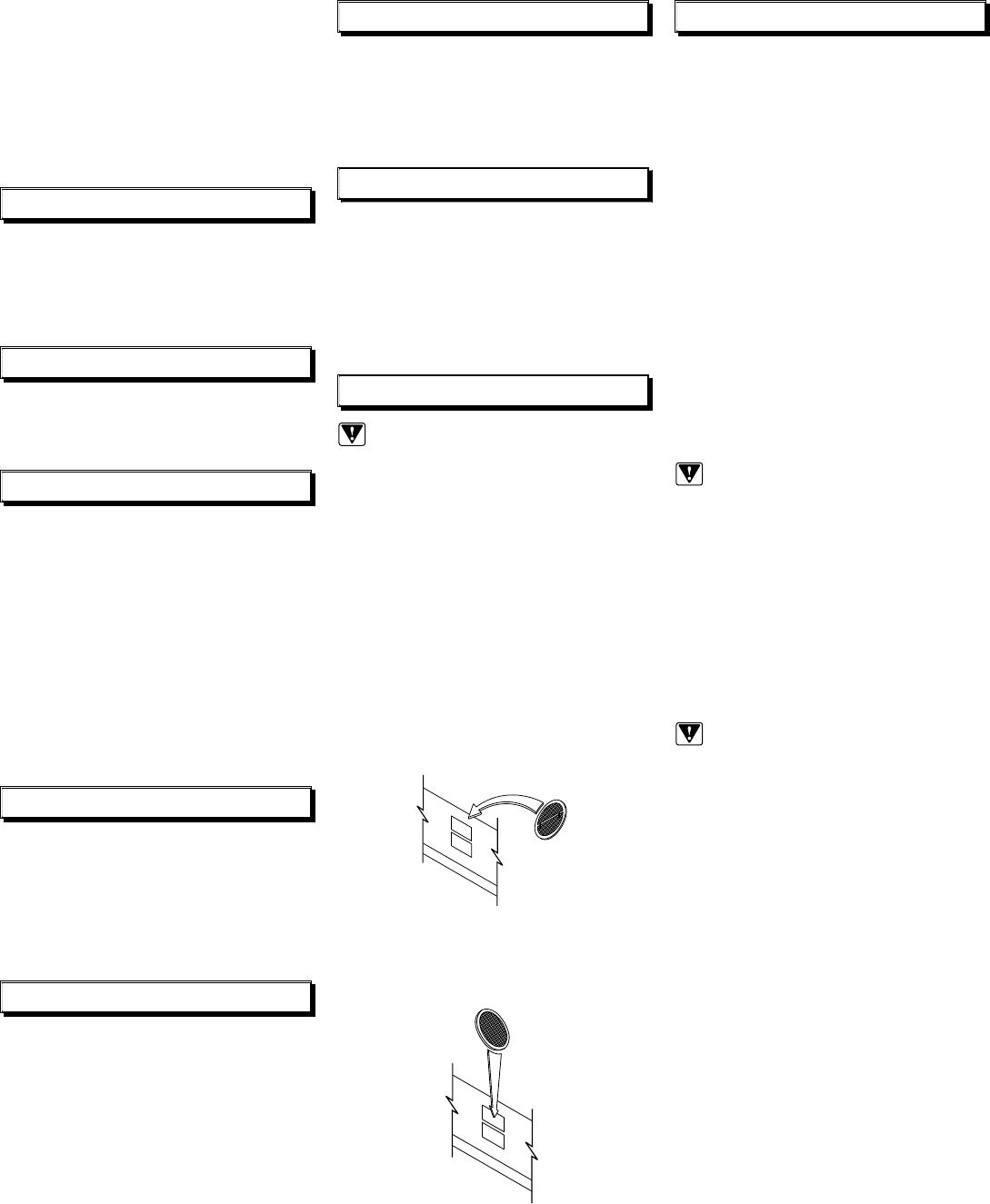
8
8
Convection Fan Filter
WARNING:
Remove the filter only when it is cool.
The convection fan filter is made of stainless
steel. Remove the filter regularly for cleaning,
as a clogged filter will reduce the effectiveness
of convection cooking modes. Soak the filter
in hot soapy water. Dry the filter completely
before re-installing. Remove the filter during
Self-Cleaning. If the filter is left in the oven
during Self-Cleaning it will permanently discolor.
Re-install the filter before cooking in the
oven again. Failure to do so will expose the
convection fan blade that rotates at high
speed during convection modes.
Step 1: Orient the filter so that the two
mounting tabs are towards the rear, open
end down.
Removing and Installing the Convection Fan Filter
Step 1
Step 2: Hook the two mounting tabs over the
center horizontal bar.
Removing and Installing the Convection Fan Filter
Step 2
Self-Cleaning
The electric door latch is a convenient safety
feature. The door latch is automatically activated
after selecting the Self-Clean mode. The latch
ensures that the oven door cannot be opened
while the interior oven temperatures are unsafe
to the user.
The oven features an automatic pyrolytic
Self-Cleaning cycle to eliminate the need for
difficult and time-consuming manual scrubbing
of interior surfaces. During this cycle, the oven
reaches temperatures of 850˚F to burn off soil
and deposits. A powder ash residue is left in the
bottom of the oven after completion of the Self-
Clean cycle.
The Self-Clean time is variable from 2 to 4
hours to offer flexibility in handling various soil
conditions. A 2-hour cycle normally handles a
moderately soiled oven, whereas a 4-hour cycle
is recommended for a heavily soiled condition.
The Self-Clean cycle can also be delayed to
start at a later time if desired.
IMPORTANT:
1. It is normal for some smoke to be
emitted during the first few Self-Clean
cycles.
2. Popping sounds are normal during Self-
Clean cycles. These sounds are caused
by the expansion and contraction of
metal surfaces during heat-up and cool-
down.
3. Do not line the oven with aluminum
foil or other materials. These items can
melt or burn during a Self-Clean cycle,
causing permanent damage to the oven.
WARNINGS:
1. DO NOT OPERATE THE OVEN LIGHTS
IN THE SELF-CLEAN MODE.
2. Do not touch the outside surfaces of the
oven during the Self-Clean cycle
3. Do not use commercial oven cleaners
inside the oven. Use of these cleaners
can produce hazardous fumes or can
permanently damage the porcelain
finishes.
Brass, Chrome & Copper Surfaces
Clean these surfaces with a solution of mild
detergent and warm water. Rinse, dry and polish
with a soft, lint-free cloth.
If a commercially available polish is used,
it is important to read the label for chlorine
compounds. Chlorine is a corrosive substance
and is not recommended for use with brass,
copper or chrome finishes. If these compounds
are present, rinse surface thoroughly and dry
with a soft, lint-free cloth.
Follow manufacturer’s instructions for
application of polish.
Broiler Pan and Grill
The oven broiler pan and grill is finished in
porcelain enamel. Clean both components in a
solution of detergent and hot water. For heavy
soil conditions, use a scouring pad such as
steel wool with plenty of water. Rinse well after
cleaning
Oven Racks
Oven racks are chrome-plated. For everyday
cleaning, apply a solution of detergent and hot
water. To clean heavy soil, use a scouring pad
such as steel wool with plenty of water, or use a
solution of 1 cup ammonia to 2 gallons of water.
Remove racks during Self-Cleaning. If racks
are left in the oven during self-cleaning, they will
permanently discolor.
Prepare the oven for Self-Cleaning by
following these steps:
1. Clean soil from the oven front frame area
and the oven door outside of the door
gasket. Do not clean the door gasket.
Cleaning the door gasket by hand can
cause it to bend or move. A tight door
seal is essential for proper baking and
Self-Cleaning. Rinse surfaces well with a
solution of vinegar and water, then wipe
dry. Heavily soiled areas may be cleaned
with a non-scratching scouring pad.
Door Handle & Control Housing
Clean the door handle and control panel
housing with a solution of mild detergent and
hot water. Rinse and dry with a soft cloth.
DO NOT USE ABRASIVE CLEANERS OR
SCRUBBERS. THEY WILL PERMANENTLY
DAMAGE THE FINISH.
Clean all glass surfaces with a solution of mild
detergent and hot water. Use a mild glass
cleaner to remove fingerprints or smears. Dry
completely with a soft, lint-free cloth.
Door Glass
Stainless Steel Surfaces
On stainless steel ovens, the control panel,
door(s) and exhaust grill are covered with
stainless steel panels. Clean these surfaces with
a solution of mild detergent and warm water.
Rinse and dry with a soft, lint-free cloth.
If commercially available stainless steel
cleaners are used, it is important to read the
labels for chlorine compounds. Chlorine is a
corrosive substance. If these compounds are
present, rinse thoroughly and dry with a soft,
lint-free cloth.
Always wipe stainless steel surfaces with the
grain.
Porcelain Surfaces
The oven interior and inner door liners are
finished in porcelain enamel. Clean these
surfaces with a solution of mild detergent and
hot water. Rinse and dry with a soft cloth.
Do not use abrasives or commercial oven
cleaners. Always remove excess grease and
soil from the oven interior and door prior to
using the Self-Cleaning cycle.
To re-activate the control panel, again push
and hold the “CANCEL•SECURE” pad for three
seconds. “OFF” will disappear from the display.
Clean the control panel with a solution of mild
detergent and warm water. DO NOT USE
ABRASIVE CLEANERS OR SCRUBBERS.
THEY WILL PERMANENTLY DAMAGE THE
FINISH. Dry the control panel completely with a
soft, lint-free cloth.



